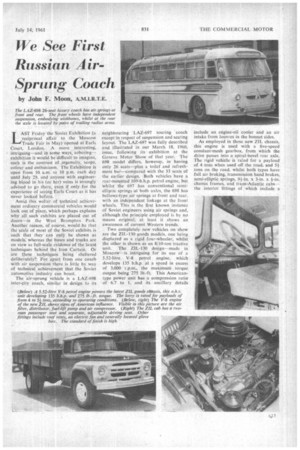We See First Russian Air Sprung Coach
Page 53

Page 54

If you've noticed an error in this article please click here to report it so we can fix it.
by John F. Moon, A.M.1.R.T.E.
LAST Friday the Soviet Exhibition (a reciprocal affait to the Moscow Trade Fair in May) opened at Earls Court, London. A more interesting, intriguing—and in some ways, sobering-7 exhibition it would be difficult to imagine, such is the contrast of. ingenuity, scope. colour and enthusiasm. The Exhibition is open From 10 a.m. to 10 p.m. each day until July 29, and anyone with engineering blood in his (or her) veins is strongly advised to go there, even if only for the experience of seeing Earls Court as it has never looked before.
• Amid. this welter of technical achievement ordinary commercial vehicles would look out of place, which perhaps explains why all such exhibits are placed out of doors—in the West Brompton Park. Another reason, of course, would -be that the scale of most of the Soviet exhibits is . such that they can only be shown as models, whereas the buses and trucks are on view as full-scale evidence of the latest techniques behind the Iron Curtain. Or arc these techniques being sheltered deliberately? For apart from one coach With air suspension there is little by. way of technical achievement that the Soviet automotive industry can boast.
The air-sprung vehicle is a LAZ-698 inter-city. coach, similar in design to its neighbouring LAZ-697 touring coach except in respect of suspension and seating layout. The LAZ-697 was fully described and illustrated in our March 18, 1960, issue, following its exhibition at the Geneva Motor Show of that year. The 698 model differs, however, in having only 26 seats—plus a toiletand refreshment bar—compared with the 33 seats of the earlier, design. Both vehicles have a rear-mounted I09-b.h.p. petrol engine, but whilst the 697 has conventional semielliptic springs at both axles, the 698 has bellows-type air springs at front and rear. with an independent linkage at the front wheels. This is the. first known instance of Soviet engineers using air springs and, although the principle employed is by no means original, at least it shows an awareness of current Western trends.
Two completely new vehicles on show are the ZIL-130-goods models, one being displayed as a rigid four-wheeler, whilst the other is shown as an 8/10-ton tractive unit. The ZIL-130 design—made in Moscow:—is intriguing for its use of a 5,52-litre V-8 petrol engine, which develops 135 b.h.p. at a sneed in excess of 3,000 r.p.m., the maximum torque output being 275 lb.-Ft. This Americantype power unit has a compression ratio of 6,7 to 1, and its ancillary details
include an engine-oil cooler and an air intake from louvres in the bonnet sides.
As employed in these new ZIL chassis, this engine is used with a five-speed constant-mesh gearbox, from which the drive passes into a spiral-bevel rear axle. The rigid vehicle is rated for a payload of 4 tons when used off the road, and 5+ tons on the road, whilst both types have full air braking, transmission hand brakes,
semi-elliptic springs, x 3-in. x t-in. chassis frames, and trans-Atlantic cabs-the interior fittings of which include a fan, hinged roof vents and seating for a crew of three.
Largest of the Russian exhibits is the MAZ 6 x 4 dumper, which has an unladen weight of 35 tons and can carry a payload of 40 tons in its 281-cu.-yd. allsteel body. This Massive machine has a V-12 diesel engine developing 450 b.h.p. (normally aspirated) and driving through a torque-converter transmission with constant-mesh main gearbox and an auxiliary box which divides the drive between the two rear-bogie axles. The dumper has semi-elliptic springs at front and rear, those at the front axle being arranged transversely, and air brakes, power steering and 18.00-23-in. tyres.
MAZ vehicles are made in Minsk, and alongside the dumper there are two mobile cranes, one of which is lorry mounted whilst the other is self-propelled. Both these are on sale in this country, the agents being B. G. Plant (Sales Agency), Ltd., Watlington, Oxon, and these are the only heavy vehicles actually offered for sale in Great Britain, although the other exhibits will be sold quite willingly if potential customers are not frightened by the import-dutied prices.
Much smaller are the two RAF Latvian-made exhibits, one of which is the latest version of the Latvia 10-seat minibus, as originally shown at Geneva last year. This has been revised to the extent of incorporating a one-piece curved windscreen, paired head-lamps and a shallow radiator grille, but the bus has now been joined by a goods-carrying version known as the UAZ-451—a forward-control i-tonner. Like the Latvia, the UAt-451 has Volga privatecar units, including a 2.5-litre, 70-b.h.p. petrol engine and four-speed synchromesh gearbox with steering-column gear change. Its 1960 brother—the Spriditis —which was smaller and had Moskvitch running units, has been abandoned as being too fragile for Russian operations.
The remaining full-sized exhibits are restricted to the LAZ-697 coach and the PAZ-652 22-seat bus, both of which were shown at Geneva last year. Vehicular interest does not end there, however. In the hall devoted to the arts there is a model of a cross-country tractor with Goodyear-Terratyre-type wheels and tyres, the design of which was formulated by a Mr. Kuznezov—student at the Leningrad school of fine arts.
In the next hall to this hypothetical design there is a model of a farming vehicle of most unusual layout. This has a backbone frame, with the fourcylindered diesel engine mounted amidships. The vehicle has no suspension, but the front axle is centrally pivoted and has power-assisted steering. The cab is carried well above the front axle, to allow for full wheel movement when traversing rough country.
































































































































